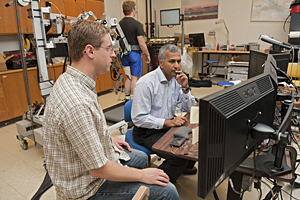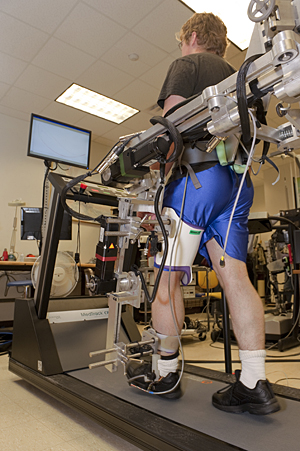

ADVERTISEMENT
- Rozovsky wins prestigious NSF Early Career Award
- UD students meet alumni, experience 'closing bell' at NYSE
- Newark Police seek assistance in identifying suspects in robbery
- Rivlin says bipartisan budget action, stronger budget rules key to reversing debt
- Stink bugs shouldn't pose problem until late summer
- Gao to honor Placido Domingo in Washington performance
- Adopt-A-Highway project keeps Lewes road clean
- WVUD's Radiothon fundraiser runs April 1-10
- W.D. Snodgrass Symposium to honor Pulitzer winner
- New guide helps cancer patients manage symptoms
- UD in the News, March 25, 2011
- For the Record, March 25, 2011
- Public opinion expert discusses world views of U.S. in Global Agenda series
- Congressional delegation, dean laud Center for Community Research and Service program
- Center for Political Communication sets symposium on politics, entertainment
- Students work to raise funds, awareness of domestic violence
- Equestrian team wins regional championship in Western riding
- Markell, Harker stress importance of agriculture to Delaware's economy
- Carol A. Ammon MBA Case Competition winners announced
- Prof presents blood-clotting studies at Gordon Research Conference
- Sexual Assault Awareness Month events, programs announced
- Stay connected with Sea Grant, CEOE e-newsletter
- A message to UD regarding the tragedy in Japan
- More News >>
- March 31-May 14: REP stages Neil Simon's 'The Good Doctor'
- April 2: Newark plans annual 'wine and dine'
- April 5: Expert perspective on U.S. health care
- April 5: Comedian Ace Guillen to visit Scrounge
- April 6, May 4: School of Nursing sponsors research lecture series
- April 6-May 4: Confucius Institute presents Chinese Film Series on Wednesdays
- April 6: IPCC's Pachauri to discuss sustainable development in DENIN Dialogue Series
- April 7: 'WVUDstock' radiothon concert announced
- April 8: English Language Institute presents 'Arts in Translation'
- April 9: Green and Healthy Living Expo planned at The Bob
- April 9: Center for Political Communication to host Onion editor
- April 10: Alumni Easter Egg-stravaganza planned
- April 11: CDS session to focus on visual assistive technologies
- April 12: T.J. Stiles to speak at UDLA annual dinner
- April 15, 16: Annual UD push lawnmower tune-up scheduled
- April 15, 16: Master Players series presents iMusic 4, China Magpie
- April 15, 16: Delaware Symphony, UD chorus to perform Mahler work
- April 18: Former NFL Coach Bill Cowher featured in UD Speaks
- April 21-24: Sesame Street Live brings Elmo and friends to The Bob
- April 30: Save the date for Ag Day 2011 at UD
- April 30: Symposium to consider 'Frontiers at the Chemistry-Biology Interface'
- April 30-May 1: Relay for Life set at Delaware Field House
- May 4: Delaware Membrane Protein Symposium announced
- May 5: Northwestern University's Leon Keer to deliver Kerr lecture
- May 7: Women's volleyball team to host second annual Spring Fling
- Through May 3: SPPA announces speakers for 10th annual lecture series
- Through May 4: Global Agenda sees U.S. through others' eyes; World Bank president to speak
- Through May 4: 'Research on Race, Ethnicity, Culture' topic of series
- Through May 9: Black American Studies announces lecture series
- Through May 11: 'Challenges in Jewish Culture' lecture series announced
- Through May 11: Area Studies research featured in speaker series
- Through June 5: 'Andy Warhol: Behind the Camera' on view in Old College Gallery
- Through July 15: 'Bodyscapes' on view at Mechanical Hall Gallery
- More What's Happening >>
- UD calendar >>
- Middle States evaluation team on campus April 5
- Phipps named HR Liaison of the Quarter
- Senior wins iPad for participating in assessment study
- April 19: Procurement Services schedules information sessions
- UD Bookstore announces spring break hours
- HealthyU Wellness Program encourages employees to 'Step into Spring'
- April 8-29: Faculty roundtable series considers student engagement
- GRE is changing; learn more at April 15 info session
- April 30: UD Evening with Blue Rocks set for employees
- Morris Library to be open 24/7 during final exams
- More Campus FYI >>
1:05 p.m., Oct. 26, 2010----Sunil K. Agrawal, professor in the Department of Mechanical Engineering at the University of Delaware, presented one of six plenary lectures at the third IEEE International Conference on Biomedical Robotics and Biomechatronics (BioRob 2010) held in Tokyo, Japan, Sept. 26-29.
Agrawal's talk discussed new developments in robotic exoskeletons for gait training of the movement impaired. The improvements, says Agrawal, show promise in helping chronic stroke survivors regain leg function and improve walking ability.
Retraining the brain to improve function
“We're learning that there is a fair amount of plasticity in the human brain that enables it to be trained with a force-field environment using robotics,” he says.
Using an actively driven leg exoskeleton (ALEX) that can modulate foot movement using motors at the joints, or a gravity balancing un-motorized orthosis (GBO) designed to alter gravity at the hip and knee joints, UD researchers are helping participants in a study to retrain the brain and improve gait function over a six-week period.
John Scholz, professor of physical therapy at UD and co-principal investigator for the study, explains that many stroke survivors develop compensatory strategies to overcome functional losses in knee flexion or dorsiflexion of the ankle on the affected side. The result, he says, is often shallow foot path and/or poor balance, which can eventually lead to secondary compensations like back pain, muscle strain and joint pathology that further impair a person's natural movement.
The ALEX robotic device helps study participants overcome learned compensation techniques by allowing them to move through a preselected footpath with a built-in window of variability, the amount of which can be selected by the trainer. The robotic device corrects movements outside the desired window using an elastic resistance similar to what physical therapists do during manual training.
“Essentially, we start with a patient's current foot trajectory and morph it toward a more normal foot trajectory over time,” says Scholz.
New design features of ALEX II, the latest device created by the research team, are less restrictive and provide study participants a greater degree of freedom in forward, backward, side-to-side trunk movement and lateral leg movement. “Human walking involves complex interaction between the upper body and the legs. We believe that subjects can learn to walk better with ALEX II which allows the motion of the trunk to be less constrained,” says Agrawal.
Functional assessments during training, and again one, three and six months following training, provide much needed data on foot speed, joint motion, toe clearance and other factors that impact walking. The data will help researchers determine if improvements are retained over time and hopefully lead to a clinical trial that would impact a larger number of people, adds Scholz.
According to Agrawal, over 700,000 people suffer strokes each year and as many as 3 million survivors are living with its after-effects. The term chronic, when applied to stroke survivors, refers to those who are six-months past their brain insult.
Other potential benefits
The research study also compares participants using this training paradigm with those using body weight supported treadmill training, a physically demanding treatment modality that involves up to two therapists manually moving the paretic leg and pelvis of a stroke survivor through a specific trajectory to achieve a desired gait pattern.
“Body weight supported treadmill training is an exhaustive task for physical therapists,” says Kyle Winfree, a graduate student in the biomechanics and movement science program. “Using robotics adaptive devices such as ALEX to assume that mundane task takes the emphasis off the actual movement and focuses it instead on individual outcomes.”
These improvements offer endless possibilities and open the door for potential future non-rehabilitation applications as well, adds Agrawal.
“This technology provides a virtual training environment that can be leveraged to improve function in other domains. For example, training workers to perform repetitive assembly functions more optimally or training athletes to learn new skills more quickly,” he suggests. “However, these applications have not yet been tried and remain to be explored in coming years.”
Agrawal, who joined UD in 1996 as an associate professor, currently serves as director of Mechanical Systems in mechanical engineering. He is principal investigator for the project, which is funded under a grant from the National Institute of Health's Bioengineering Research Partnerships program.
About BioRob
BioRob is a highly interdisciplinary conference that draws together scientists and engineers from different backgrounds and countries to share and learn how researchers are applying robotics and mechatronics in medicine and biology. The event is jointly sponsored by the IEEE Robotics and Automation Society and the IEEE Engineering in Medicine and Biology Society. Agrawal served on the executive program committee for the event.
Article by Karen B. Roberts
Photos by Evan Krape


